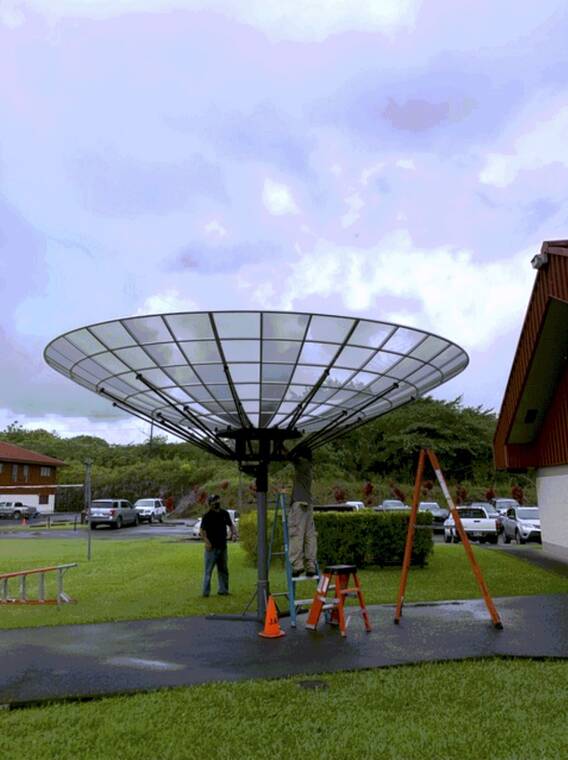After months of delays, a proposal to build a Taiwanese satellite receiver array in a remote part of Ka‘u has been greenlit by the Windward Planning Commission.
The Academia Sinica Institute of Astronomy and Astrophysics plans to install a system of 10 satellite dishes 20 feet in diameter on a two-acre site on a larger 10.7-acre parcel in Wood Valley in order to observe faint radio pulses from deep space.
Those pulses, called Fast Radio Bursts, are extremely energetic at their source, but Geoff Bower, ASIAA’s chief scientist for Hawaii Operations, told the commission Thursday that by the time they reach Earth, they are so faint as to be drowned out by terrestrial radio signals.
Because of this, ASIAA chose Ka‘u for its remoteness, with Bower describing the area as “radio silent,” and therefore better suited to detect the radio bursts.
“As optical astronomy suffers from light pollution, radio astronomy suffers from radio frequency interference,” Bower said. “So, an isolated location shielded from television, cellphone (signals) … by the mountain that surrounds the valley makes it very special.”
Meanwhile, Bower said the array’s location on the Big Island will allow it to triangulate findings with other arrays in Asia and North America, letting astronomers to observe the sky for a longer period of time.
Bower emphasized that the array is wholly passive and emits no signals of its own, merely picking up radio bursts as they come, and that the array’s footprint — which includes a small solar installation connected to the satellite dishes via underground power lines — is intended to be as small as possible. He said also said the installation would be temporary, lasting only a maximum of 10 years.
Despite this, the project has generated not a small amount of criticism from residents. Last May, ASIAA previously proposed to build the array at another site in Wood Valley about two miles away from the current proposed location, but ultimately dropped that plan after residents raised concerns that the project would overtax local roads and disturb neighboring properties.
Residents also testified Thursday against the new proposed site. Noa Caiserman said she lives only a quarter of a mile away from the site, and warned that the project would negatively impact “all of Hawaii Island.”
“There are other places that you could consider … where you could do this kind of work that are not as beautiful, but they are as silent,” Caiserman said.
Another Wood Valley resident, Sandra Reha, said as much Ka‘u land as possible should be kept for agricultural purposes to promote food sustainability, and that ASIAA’s use of the land would not serve the local community.
Another doubter was commission Chair Dennis Lin, who initially voted against recommending ASIAA’s application for a special permit for the area.
“I’m sure there’s other locations on this island that could be radio silent,” Lin said. “I’m not saying I’m against science, I’m just saying there’s options out there.”
But a speech by Ming-Tang Chen, ASIAA’s deputy director for Hawaii operations, evidently changed Lin’s mind.
“What we can offer is more educational outreach,” Chen said. “For example, we can go to the Ka‘u community, to high schools, to promote science, to talk about astronomy. If students are interested, we can take in interns. … If they are doing really well, we can even show them to our international partners as internship opportunities. That is what we can offer, as our appreciation to the community. You have my word. We can do it.”
“That’s the piece we were missing, your commitment,” Lin responded. “What I was looking for was exactly what you just said.”
However, Bower offered a stick to complement Chen’s carrot: Because ASIAA’s application had been deferred for more than four months — it was initially meant to be discussed at the commission’s January meeting, but two commissioners repeatedly recused themselves because of conflicts of interest, thereby preventing a quorum from being reached for several months — Bower said ASIAA could be legally entitled to have its application approved outright.
“There are planning commission rules that relate to time to perform certain duties,” Bower said. “Within 60 days after the close of a hearing, the planning commission has to confirm or deny an application. … The time has elapsed to make a decision, so based on planning commission rules … it would appear this application, by technicality, has already been approved.
“We don’t want to sidestep the authority,” Bower continued. “We think the public dialogue, your mana‘o, your experience, is very important. … But, just in case of litigation or appeal, I have to make these statements on the record.”
But regardless of the reason why, Lin voted in favor of ASIAA’s application on a second vote, with the condition that ASIAA provide an annual report about its public outreach efforts.
The commission voted 4-0 in favor, with two commissioners abstaining.
Email Michael Brestovansky at mbrestovansky@hawaiitribune-herald.com.






